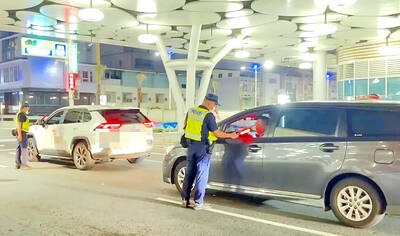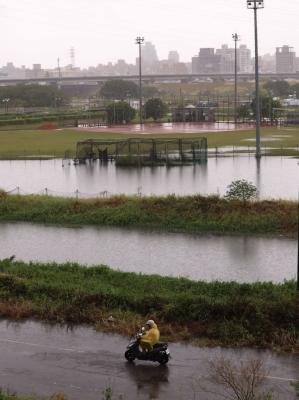Smoke billows daily from temples across the nation as visitors burn incense and paper money to bring luck and prosperity — but that familiar fragrant haze could be a thing of the past as concerns grow over ritual pollutants.
The potential damage to the environment and to the health of devotees from staggering levels of dangerous particles in the air is leading some temples and festivals to seek alternative — if less spectacular — practices, despite resistance from worshipers.
Famous temples such as the Taoist Nan Yao Temple (南瑤宮) in Changhua City — one of the nation’s largest and oldest temples — are playing firecracker CDs instead of launching the real thing, as well as encouraging followers to clap hands to create smoke-free noise.

Photo: Ting Wei-chieh, Taipei Times
The popular Taoist Hsing Tian Kong (行天宮) temple in Taipei has banned worshipers from burning incense, requesting that they simply bring their hands together to pray, instead of holding the burning sticks.
Other temples are sending paper offerings to be burned at state incinerators so the fumes can be treated.
And in New Taipei City, water lanterns that pollute the river have been replaced with a wall of lanterns outside a temple.
While the new alternatives might not be quite as atmospheric, campaigners say it is time for change.
“People come to temples to pray for good health, but the way they are worshipping is not healthy,” said Yeh Guang-perng (葉光芃), founder of the environmental group Air Clean for Taiwan. “They might not get sick right away, but long-term exposure would be harmful to their health.”
Taoism and Buddhism are the predominant faiths in the nation, each with millions of followers and with worship centering around temples and festival events.
During a nine-day pilgrimage last month in central Taiwan honoring the Taoist sea goddess Matsu, government monitoring revealed levels of harmful microscopic PM2.5 particles — fine particles less than 2.5 micrometers in diameter — reached more than 60 times the WHO’s recommended levels along the route after multiple firecrackers were set off.
Environmental groups have also warned over hazardous chemicals, such as benzene and methylbenzene, released from burning incense and paper money.
However, some devotees are reluctant to let go.
“The traditional belief is that the more firecrackers and incense used, the sincerer the faithful will appear and the more good fortune will be bestowed on them,” said Chiu Chien-fu (邱建富), director of Nan Yao Temple.
The temple for the first time canceled a budget of NT$1 million (US$30,576) for setting off firecrackers at a recent Matsu pilgrimage it hosted, but about half of its devotees refused to follow suit and set off their own, he said.
Dajia Jenn Lann Temple (大甲鎮瀾宮), in Taichung’s Dajia District (大甲), also Taoist, is encouraging worshipers to dedicate fresh flowers and fruits to deities, and to donate the money they would spend on firecrackers to charity.
Again, the reaction has been mixed from worshipers.
“Actually the smog coming from China is far more serious. Air pollution is not caused by religious activities alone,” read one message on the temple’s Facebook page.
“Some followers are unhappy, especially older people who think they are being disrespectful and we cannot force them. It is not easy to change,” temple chairman Yen Chin-piao (顏清標) said.
Authorities are banking on a scientific approach to persuade skeptical worshipers to go “green.”
The levels of PM2.5 at last month’s main Matsu festival pilgrimage were posted real-time online by the Environmental Protection Administration (EPA), which sent a dedicated team to follow the celebrations for the first time.
“We hope that with the scientific proof from the on-site data, we can persuade the public to change,” the EPA’s Air Quality Protection and Noise Control Department head Chen Shyan-heng (陳咸亨) said.
The EPA has promised to bring in new restrictions on the amount, location and timings for setting off firecrackers within the next year, after pressure from lawmakers shocked by air pollution at the Matsu celebrations.
Only setting off firecrackers at restricted hours is punishable under a noise control law, with a maximum fine of NT$30,000.
There is no official record of how many religious establishments are adopting “green” approaches.

TRAFFIC SAFETY RULES: A positive result in a drug test would result in a two-year license suspension for the driver and vehicle, and a fine of up to NT$180,000 The Ministry of Transportation and Communications is to authorize police to conduct roadside saliva tests by the end of the year to deter people from driving while under the influence of narcotics, it said yesterday. The ministry last month unveiled a draft of amended regulations governing traffic safety rules and penalties, which included provisions empowering police to conduct mandatory saliva tests on drivers. While currently rules authorize police to use oral fluid testing kits for signs of drug use, they do not establish penalties for noncompliance or operating procedures for officers to follow, the ministry said. The proposed changes to the regulations require

The Executive Yuan yesterday announced that registration for a one-time universal NT$10,000 cash handout to help people in Taiwan survive US tariffs and inflation would start on Nov. 5, with payouts available as early as Nov. 12. Who is eligible for the handout? Registered Taiwanese nationals are eligible, including those born in Taiwan before April 30 next year with a birth certificate. Non-registered nationals with residence permits, foreign permanent residents and foreign spouses of Taiwanese citizens with residence permits also qualify for the handouts. For people who meet the eligibility requirements, but passed away between yesterday and April 30 next year, surviving family members

Taipei, New Taipei City, Keelung and Taoyuan would issue a decision at 8pm on whether to cancel work and school tomorrow due to forecasted heavy rain, Keelung Mayor Hsieh Kuo-liang (謝國樑) said today. Hsieh told reporters that absent some pressing reason, the four northern cities would announce the decision jointly at 8pm. Keelung is expected to receive between 300mm and 490mm of rain in the period from 2pm today through 2pm tomorrow, Central Weather Administration data showed. Keelung City Government regulations stipulate that school and work can be canceled if rain totals in mountainous or low-elevation areas are forecast to exceed 350mm in

China Airlines Ltd (CAL) yesterday morning joined SkyTeam’s Aviation Challenge for the fourth time, operating a demonstration flight for “net zero carbon emissions” from Taiwan Taoyuan International Airport to Bangkok. The flight used sustainable aviation fuel (SAF) at a ratio of up to 40 percent, the highest proportion CAL has achieved to date, the nation’s largest carrier said. Since April, SAF has become available to Taiwanese international carriers at Taipei International Airport (Songshan airport), Kaohsiung International Airport and Taoyuan airport. In previous challenges, CAL operated “net zero carbon emission flights” to Singapore and Japan. At a ceremony at Taoyuan airport, China Airlines chief sustainability